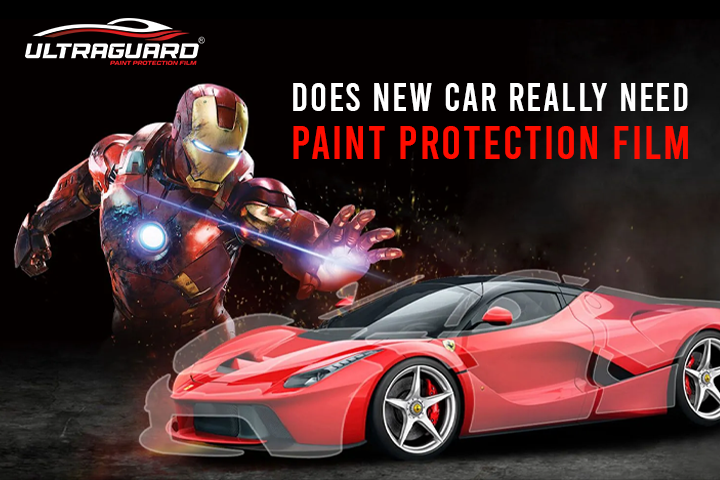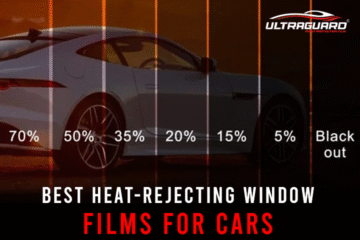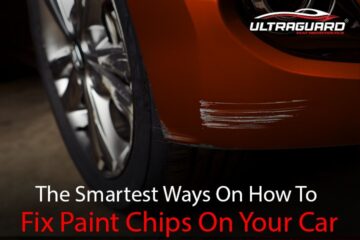This question of How do I keep this paint perfect? It inevitably leads to the premium solution: Paint Protection Film (PPF), often referred to as a “clear bra.” It’s an investment, and you’re smart to question whether your Car Really Needs Paint Protection Film.
Let’s be honest: the decision isn’t about luxury; it’s about protection, peace of mind, and the real-world value of your investment. Let’s see everything about it through this blog.

Is That Brand-New Clear Coat Already Broken?
We all love that fresh factory paint. It looks miles deep, perfectly smooth, and you assume it can handle anything. The hard truth, though, is that the clear coat on your New Car Really Needs Paint Protection Film because it’s surprisingly soft and thin. It’s designed to appear excellent, not awful.
Think of it this way: Every mile you run is a small warfare.
- Physical damage: That little sound you heard while a vehicle passes you on the road? That’s a rock tearing a microscopic crater in your paint. Waxes and sealants are useless against this level of impact damage.
- Chemical stains: Bird droppings and bug splatter are not the easiest gross; they’re additionally acidic. If you let them bake in the sun for a day, they’ll leave a permanent stain on your clear coat.
- Swirl marks and scratches: Even after polishing, washing, and drying the car, small scratches (swirl marks) can also remain, which later ruin the shine.
If your primary goal is to keep your paint physically flawless and preserve the “new car” look for years, then yes, your Car needs Paint Protection Film.
What Is PPF, and Why Is It an Actual Guard?
Paint Protection Film is a thermoplastic urethane film that is thick, bendy, and absolutely obvious. It’s an invisible defense that takes harm, so your paint takes no damage.
Here’s the human side of the technology:
- It Sacrifices Itself: The PPF absorbs the impact of rocks and debris, often stretching or tearing slightly, but leaving the paint underneath untouched. It’s the ultimate sacrificial layer.
- It Heals Itself: This is the magic trick. Most quality films are “self-healing.” Is there a small scratch or swirl mark on the film from a horrific wash or a jacket zipper? Just follow a little heat (park it under the sun, put warm water, or use a heat gun) and the film will visibly ease out, easily erasing imperfections.
- It makes life clean: cleaning is straightforward. Washing is less demanding. You can drive your car without hesitation without the need to pay attention to a pebble that hits the fender.
Here’s the good news that PPF doesn’t have to be an all-or-nothing decision! You can strategically place the Paint Protection Film exactly where your car takes the most abuse.
It’s all about balancing your budget with your peace of mind. Based on years of seeing real-world road damage, here are the three specific areas where you should place the paint protection film:
1. Major Hitting Zones
This is the non-negotiable, absolute bare minimum for any car driven on the highway. We focus on the areas that are rock chip magnets:
| Area We Cover | Why We Cover It |
| Front Bumper | This is the car’s shield. It catches everything. Protecting this saves you from countless chips. |
| Partial Hood & Fenders | We wrap the first 18-24 inches (the leading edge). This is where most rocks hit their peak trajectory. |
| Side Mirrors | These get sandblasted on the highway, which may make the end of the appearance look ugly over the years. |
This entry-level option is fantastic for the budget-conscious. It protects the parts that will be chipped first. Just remember, you might see a subtle line across the hood where the film ends. For some, that’s a small price to pay for big protection.
2. Safeguarding of the Front End
If you’re serious about protecting that new car feeling and preventing any visible lines, this is the package. It’s a full, seamless wrap of the entire front clip:
| Area We Cover | Why We Cover It (The Seamless Upgrade) |
| Full Bumper, Full Hood, Full Fenders | No lines, no visible edges. It completely hides the PPF, and the Car Really Needs Paint Protection Film across all these forward panels for total peace. |
| Headlights & Fog Lights | This is key! It stops them from fogging, pitting, or yellowing, which saves you major money and keeps your visibility sharp. |
If you believe your New Car Really Needs Paint Protection Film and you plan on keeping it for five years or more, this is the best investment. You get a seamless, perfect look and maximum defense where 90% of the damage occurs.
3. Complete Protection
It’s for the car enthusiast, or anybody who treats their automobile like a work of art.
| Area We Cover | Why We Cover It (The Ultimate Defense) |
| Every Painted Surface | Full coverage from nose to tail, including the roof, doors, and rear bumper. |
| Door Edges and Sills | That dreaded “door ding” from a parking lot neighbor, or chips when a passenger swings the door open too wide? |
This degree of commitment is usually for one-of-a-kind cars. It gives you authentic 360-degree safety in opposition to all dangers together including stones, careless shoppers, key scratches, and unintended damage. You preserve the car for max entertainment and without a doubt, the pinnacle resale cost.
How Do I Know If My Budget & Lifestyle Justify the Cost?
This is the key, and PPF is an investment. To figure out if it’s the right one for you, put yourself through this quick questionnaire:
1. What is My “Stress Level” Around Imperfections?
| Scenario | PPF Verdict | The Logic |
| I obsess over every tiny scratch and rock chip. | Install PPF | PPF is your only path to peace of mind. It shields you from the daily agony of seeing new damage. |
| I tend to drive rough roads/highways daily. | Install PPF | Your car is in a high-risk environment. Without it, you are guaranteed to have damage within months. |
| I plan to keep this car for 5+ years. | Install PPF | It preserves your asset, maintaining a vastly higher quality finish that pays off in personal enjoyment and resale value. |
| I’m leasing or selling in 2-3 years, but want max value. | Consider PPF | Front-end safety avoids high-priced repair charges and maximizes the/resale price. |
2. When is the appropriate time to put it in?
The highest quality time is what we name the “golden window”: as soon as viable after transport, preferably inside the first 1-2 weeks.
Here’s why you shouldn’t wait:
You want to seal in factory-perfect paint, not factory-perfect paint plus a few rock chips. If you wait and drive the car for six months, I have to charge you for paint correction (polishing out swirls and chips) before I can even apply the film. That adds hundreds to your bill. Having paint safety film made immediately is the most efficient and cost-effective manner to get perfect outcomes.
Conclusion
Ultimately, the selection to install Ultraguard Paint Protection Film reflects how much you value your vehicle and how you plan to apply it. If your goal is to reduce stress, maximize protection against actual street horrors, and keep that exceptional manufacturing facility end for years, then sure, the funding in PPF is absolutely worth it. It’s the only way to truly halt physical damage and preserve the joy of a new car. So get the PPF now by contacting us on +91-93-10000-356.
Frequently Asked Questions (FAQs)
Q1. Is it beneficial to get PPF done on new cars?
Yes, of course, it is beneficial to get the paint protection film done on a new car. By this, you will be able to maintain your car from its start, and will be able to keep your car’s resale value protected.
Q2. What are some of the alternatives to PPF?
Though there are no equal or better alternative options to a PPF but here are some relatable ones as follows:
- Spray-on paint protection film
- Ceramic coating
- Vinyl Wraps
- Wax and sealants
Q3. Should I get my car with the paint protection film installation?
Yes, you should get the PPF done on your car, as it enhances the protection of your vehicle’s paint from several harmful environmental components.
Q4. What is the ideal protective coating for any new vehicle?
One of the perfect coatings for any new car is as follows:
- paint protection film – Maximum level of physical protection
- Ceramic coating – Enhance gloss and hydrophobic nature
Q5. How for an extended period of time do a paint protection film lasts?
A high-quality paint protection film lasts from 5 to 10 years, but all of it also depends on your driving habits and maintenance.
Q6. Which one is the best paint protection film for new cars?
Ultraguard PPF is one of the best paint protection films for new cars. As its PPF base film, Polycaprolactone Aliphatic TPU has been sourced from prominent companies like Lubrizol, BASF, Mitsui, Wanhua, and for the last layer, adhesive has been taken from Ashland Glue.




0 Comments